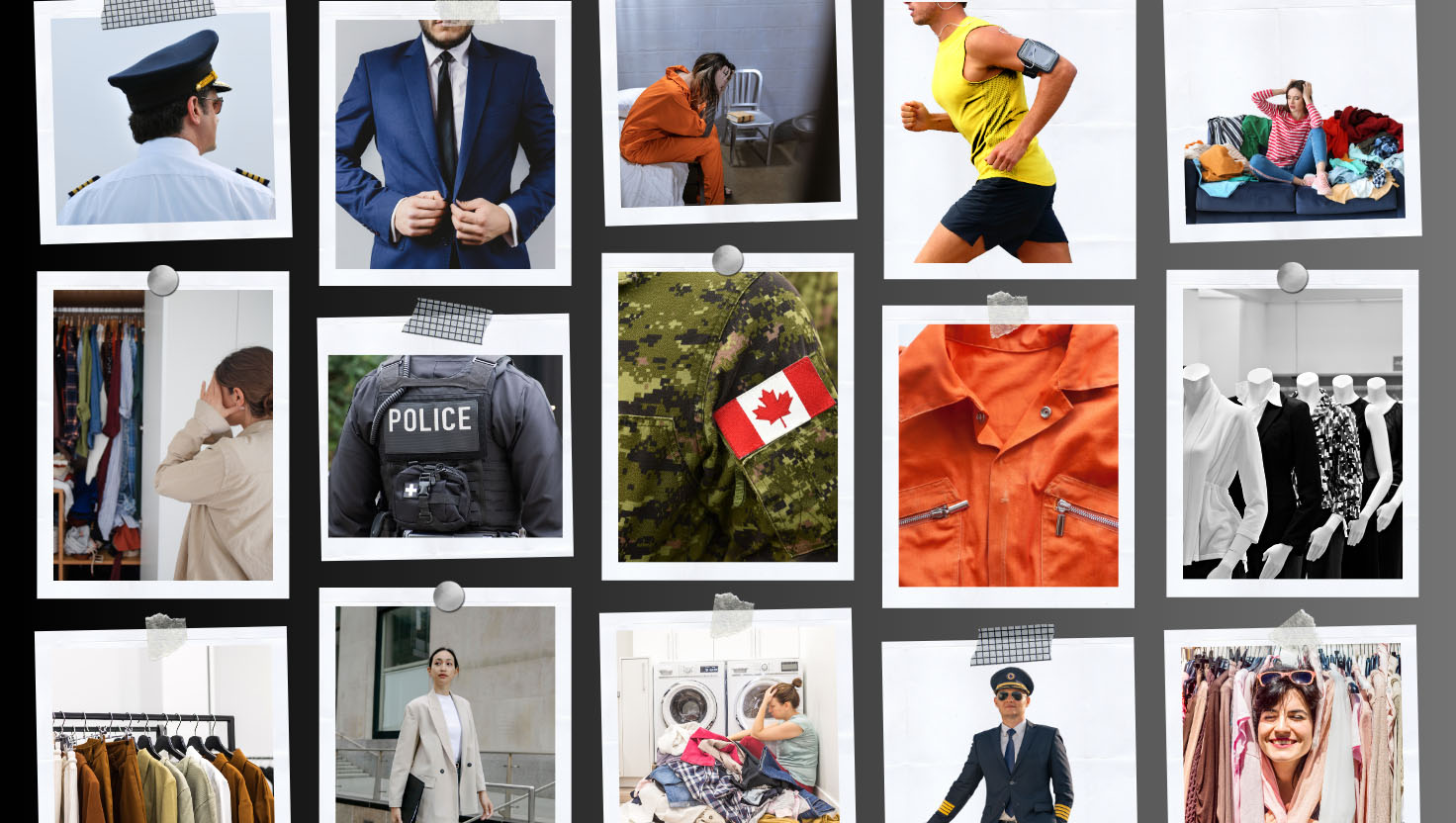How clothing shapes perception

caption
A collage of uniforms and clothing.What you wear holds more power than you think
The door shuts behind Rebecca Ketelaars. She scans the room, seeing 12 prisoners dressed in identical hunter green track pants and lime green T-shirts.
They are stripped of any individuality by the uniform they wear. The clothes don’t belong to them; they’re just symbols of incarceration.
Clothing doesn’t just fill our closets; experts say it shapes our sense of self. From prison greens to a pilot’s shirt, what we wear influences our mood, behaviour and even how others see us.
Behind bars
Ketelaars is a psychologist, group facilitator and volunteer with Prison Fellowship in Ontario, a 44-year-old non-profit that helps prisoners prepare for reintegration through community-based support and cognitive behavioural therapy for conditions like anger management.
She works with inmates in both the provincial and federal systems.
“The provincial system is more punitive,” Ketelaars says. Inmates wear standard clothing – rubber-soled shoes without laces, hunter green track pants, lime green T-shirts, and matching sweatshirts.
Ketelaars, who works with groups of 12, describes the reality of their environment. “The doors are closed, and there are no door handles on the inside. If anyone needs out, I have to knock for the guards.”
The clothing, she said, is part of their punishment.
“They’re very institutionalized, and the uniform reinforces that.”
Some prisoners are genuinely trying to rehabilitate.
“But they look the same as the person next to them – a murderer or a drug dealer – and I’m sure that takes a toll on their self-identity,” said Ketelaars.
The federal system is more rehabilitative. Inmates live in pods and can wear their own clothes, allowing them to “look more like themselves,” an important step in helping them deinstitutionalize themselves, Ketelaars says.
Does clothing affect their behaviour? “Absolutely.”
Dressed to impress (your brain)
Clothing doesn’t just change how others view us – it shapes how we see ourselves.
A 2012 study in the Journal of Experimental Social Psychology, by Hajo Adam and Adam D. Galinsky, explores how clothing affects how we are perceived through what they have termed “enclothed cognition.”
Adam, a professor of management at the University of Bath and Galinsky, a professor of leadership and ethics at Columbia, say traditional theories of cognition are abstract content, while embodied cognition is rooted in our senses. Enclothed cognition differs from both.
“Wearing clothes causes people to ‘embody’ clothing and its symbolic meaning,” Adam and Galinsky say. Unlike embodied cognition, where the link between experience and meaning is direct, enclothed cognition creates an indirect link.
“It is the clothes that carry the symbolic meaning,” the study said.
Wings of confidence
The first time Philemon Lee wore his uniform was defined by two emotions: pride and confidence.
For Lee, a Latitude air ambulance pilot in Hamilton, Ont., the uniform made it feel official, like he was representing something larger than himself.
The uniform plays an important role in shaping how pilots like Lee are perceived by both colleagues and the public.
“Often as a pilot, you gotta get down and dirty in a white shirt,” he says with a laugh. Yet despite this, the uniform serves as a symbol of control and trust.
Lee said the uniform sets him apart, offering reassurance to the patients he’s carrying.
He said wearing a uniform affects how seriously others view his role, but also how he perceives himself.
“When I have a uniform on, everyone is looking at me, thinking, ‘He’s a pilot, he’s a pilot, he’s a pilot,’ ” Lee says.
Customer empowerment
Everyday clothing, experts say, can give wearers a sense of confidence. Athletic wear, for instance, is marketed as a way of enhancing performance and encouraging a mindset of empowerment.
Kelly Thain, a former merchandiser at Nike Johannesburg, said clothing shapes both body and mind.
Nike, a worldwide sports apparel company, taps into the emotional connection between clothing and identity in its marketing, Thain said.
“The emotion is always positive, something that people watch and connect to,” says Thain. But Nike isn’t just selling clothing, it’s selling empowerment, the belief that what you wear can elevate your performance and sense of self, she said.
Thain highlights the effect of wearing the right clothing, especially in athletic performance. “If the clothing fits well and makes the person feel good, they feel like their abilities are heightened,” she said.
The uniform effect
Sometimes, uniforms project safety and security to the public, becoming a visible assurance of order.
Robert Fox, a sergeant major with Halifax Regional Police, has worn a uniform since he was a cadet at 12.
“I’ve always felt proud to wear the uniform, and I feel proud still to this day,” said Fox. He said it symbolizes his service to his country and his community.
As one of Halifax’s watch commanders, Fox oversees patrol members, maintaining order, and ensuring public safety during his shifts. He is also responsible for upholding HRP’s standards of dress and deportment, ensuring officers present an authoritative figure to the public.
For Fox, wearing the uniform is more than just following a dress code. He said it’s an outward symbol of authority to the public.
“We get calls asking for more officers to be seen in marked vehicles because when you see a marked police car, people tend not to speed,” says Fox.
Fox has also spent time in plain clothes as a detective.
“As a plainclothed officer, I get more assistance from businesses and witnesses,” Fox says, adding that criminals or those who want discretion prefer dealing with an officer not in uniform.
However, in moments of distress, the uniform takes precedence.
“When people are in trouble or need help, they want a uniformed officer,” says Fox.
A battlefield of emotions
A mix of emotions surrounds many who put on a uniform for the first time, as feelings of responsibility, pride and anticipation take a hold. For some, it’s more than getting dressed, it’s stepping into a role that shapes who they are and how others see them.
“I looked like a soldier with no idea how to be one,” says military police reservist Grace Middleton of the Canadian Army, as she reflects on the first time she donned her relish green Canadian Disruptive Pattern (CADPAT) uniform. Middleton joined the army three days after her 21st birthday.
The concept of CADPAT began in 1988 with new helmet covers, leading to the adoption of the digital camouflage uniform worn by Canadian soldiers today.
In her first days in the army, she felt overwhelmed and clueless, with contradicting feelings of excitement, anxiety, pride and fear.
Now, Middleton describes her emotions as eager, conscientious and dignified. “Every day when I am putting on my uniform, I am reminded when I look on my left shoulder, that I am representing my country,” she says.
This summer, Middleton worked alongside regular force military police during Air Show Atlantic in Greenwood. Though she was unfamiliar with the base, she was assigned to handle traffic control for over 5,000 guests attending the event that week. While directing cars and answering questions, Middleton realized how much the public was relying on her.
She said that when people see someone in a military uniform on a military base, they expect that person to know what they’re doing. In that moment, she realized the uniform wasn’t just an emblem but a call to adapt and rise to the situation.
The uniform, Middleton says, pushes you to strive for greatness, demonstrate dignity and honour those who went before you. It reflects the core principles of discipline and stewardship, which are key professional standards in the Canadian Armed Forces.
Middleton’s experience underscores the importance our clothing has on our day-to-day mood and perception of ourselves. How we dress not only embodies our uniqueness or trendiness, but our purpose and goals that we have chosen to follow.
“Once I finish my last button on my tunic,” she says. “I am ready to serve my country.”
In the end, what we wear isn’t just fabric or fashion – it’s a statement, a symbol and sometimes even a shield. From a psychologist working behind bars to a military police reservist in uniform, clothing shapes their roles and identities in ways that run deeper than the material itself.
About the author

Ella Karan
Ella Karan is in the fourth year of the King's BJH program. Originally from South Africa, she enjoys photography and writing about culture, conservation...
